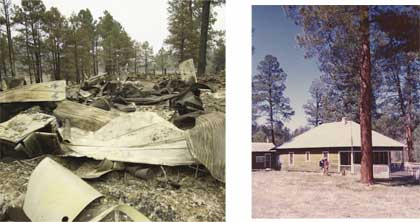|
|
|
| Subscriptions click here for 20% off! | E-Mail: info@rangemagazine.com |

|
We are paying a much greater and more personal price for our failure to rise up and save our forests. We are losing the icons of the age like Zane Grey’s home and the ranches that forged Arizona’s character and made Arizonans what we are today. We need to repair forests to save Arizona’s heritage. By Frank Carroll
July 03, 2002—One of the sweet and gentle places of my youth died in the firestorm in Arizona this past week. The Black Canyon Ranch was a historic place, witness to the Pleasant Valley War, a feud between the Grahams and the Tewksburys in Arizona in 1886. One of Arizona’s most famous shootouts occurred in the course of that war. The Black Canyon Ranch house sat near the edge of the Mogollon Rim, a breathtaking geological feature that separates what used to be the tall, cool pine country of northern Arizona from the harsher desert valley below. Cowboys and sheep men would move livestock from the low to the high country depending on the season. Zane Grey lived in the neighborhood. His house and original manuscripts were burned in a similar forest fire a few years ago. Cowboys hated sheep eaters and vice versa. My relations were cowboys, a former drugstore owner from Chicago who headed out West in the ’30s, married a Gibson girl, then settled down to a storybook life running cows in Arizona’s high country. Each year at Easter my family would travel to the Halter Cross Ranch near Overgaard to stay with Gibby and Margaret Gibson, ride horses, shoot guns, eat beans and steak and drink milk fresh out of the cow. We’d go over to the Black Canyon Ranch in the normal course of the workday, a working ranch and a place where the Gibson family liked to have wedding receptions and other celebrations. It was a magical place haunted with
ghosts. If I stayed real still and listened real close I could just make out, through the wind blowing through the old pines, the soft clap of shod hooves, a memory of what used to be. It’s good that I have those memories of long ago so firmly fixed in my mind’s eye. It’s all gone now: the house, the pines, the sweet smell of the Rim country in the summer— burned to white ash by a fire that didn’t have to happen. We are losing our Arizona heritage in a series of natural disasters that are not natural. The pine trees and the wildlife and the forest environment are gone, maybe not forever but certainly for our lifetimes. And we are paying a much greater and more personal price for our failure to rise up and save for ourselves our heritage forests. We are losing the icons of the age like Zane Grey’s home and the Black Canyon Ranch that forged Arizona’s character and made Arizonans what we are today. Make no mistake; the fires will not end until something changes the forest conditions that allow the fires to burn so hot. The only thing that will change those conditions is people armed with chainsaws and mechanical tree harvesting equipment thinning out the trees so that our forests can survive the fire next time. Arizonans are going to have to go cut trees, lots of trees, if the picture is going to change. This is not a call for commercial logging. There is no commercial timber industry left in Arizona. It is the clear recognition that loggers are going to be part of the solution to the mounting and desperate problem in Arizona’s ponderosa pine forests. Blame whomever you will. The point is we are now facing a plague of trees growing in numbers never seen before in places too dry to support them. Where 30 to 70 trees used to grow in open stands with grass underneath, where fires burned every two to 20 years to keep things open and clean, there are now 3,000 trees to each acre, small, stunted, warped, and ready to explode. And they’re not just little trees. After a half century of fire suppression, many of the trees that are now adding fuel to these fires are large. Many of them will have to come down as well if conditions are to be restored. Arizona’s pine country is not a political football, a sacrifice to environmental agendas or America’s need for wood fiber. Arizona’s pine country is our national heritage, a harbor for our cultural heritage. Only radical surgery will save it. Frank Carroll, a native Arizonan and a 25-year veteran of the U.S. Forest Service, specializes in natural resources and environmental policy in government and private industry. Carroll served on the Coconino National Forest in Flagstaff for seven years and has fought fire in the Mogollon Rim country. He is widely published in newspapers and magazines, including peer-reviewed publications like The Journal of Forestry. He can be reached at <fcarrolls1@msn.com>. |
||||||
|
Fall 2002 Contents To Subscribe: Please click here or call 1-800-RANGE-4-U for a special web price Copyright © 1998-2005 RANGE magazine For problems or questions regarding this site, please contact Dolphin Enterprises. last page update: 04.03.05 |
|||

